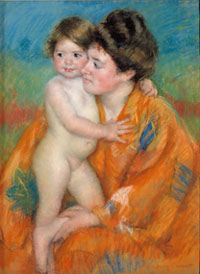Nineteenth-Century Pastels
July 24–October 24, 2004

Mary Cassatt
Woman with Baby
c. 1902, pastel (The Clark. Gift of the Executors of Governor Lehman's Estate and the Edith and Herbert Lehman Foundation)
Pastel is one of the most delicate yet versatile drawing techniques. Utilizing fabricated chalks made from powdered pigments, it allows a broad range of colors that may be blended to produce effects comparable to oil painting. During the eighteenth century pastel was especially favored for portraiture. In the hands of nineteenth-century artists, it was used with great freedom in a variety of genres, including landscape, cityscape, and scenes of modern life. The Impressionists made pastels on the scale of paintings and included them in their group exhibitions. Camille Pissarro’s Boulevard de Clichy, Effect of Winter Sunlight was shown in the sixth Impressionist exhibition of 1881. Mary Cassatt revitalized the tradition of pastel portraiture with her brilliant depictions of mothers and children.